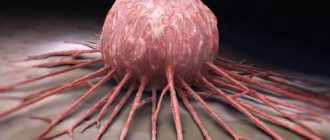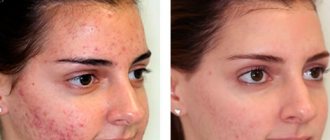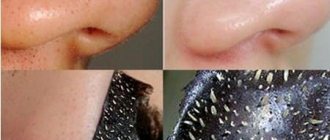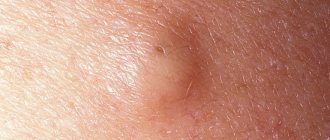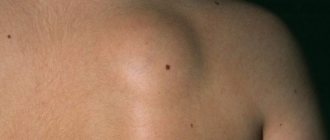The neck is one of the most sensitive parts of the human body and therefore all sorts of skin problems and irritations often occur on it, which are a signal of problems in the functioning of the body. One of these pathologies is atheroma on the neck. This is a benign formation that develops as a result of blockage and malfunction of the ducts of the sebaceous glands. The lump can appear anywhere and never goes away on its own without proper treatment. The cyst looks harmless and does not develop into cancer, but it poses a serious health hazard and can cause complications.
Form and content
It is not difficult to identify a tumor. It is a yellow round formation with a diameter of up to five cm. In the absence of appropriate treatment, the growth of the cyst can occur over decades and reach quite large sizes.
The inner layer is squamous epithelium, filled with a thick gray-yellow mass. It consists of drops of fat, particles of tissue and skin. Fatty and keratinized substances with a fibrous structure have the consistency of cottage cheese.
When an infection occurs, the mixture turns into white or brown pus. The brown color indicates an inflammatory process that is going on inside. In this case, you must immediately consult a doctor, as suppuration occurs.
Main symptoms
Externally, the wen looks like a small hump growing from under the skin. Basically, atheroma reaches a size of one to three centimeters. Large atheroma occurs in case of suppuration. A non-inflamed cyst is dense and painless to the touch, with clear edges, moves inside the tissue, but is fused to the skin. If you look more closely, you can see a clogged sebaceous duct in the center of the formation.
If you press on the atheroma, a little white or yellowish substance with a cheesy consistency may come out of this duct. But doctors strongly do not recommend squeezing out the contents of the capsule or trying to open the atheroma in any way. In such cases, it often becomes inflamed and leads to complications. The symptoms of a festering wen are:
- redness of the skin on the formation and around it;
- hyperthermia of surrounding tissues;
- increased body temperature;
- fever;
- signs of general intoxication of the body (when opening the atheroma capsule).
We recommend reading Ovarian fibroid - causes, types, treatment
If signs of suppuration appear, the use of traditional medicine recipes is strictly prohibited. In such cases, it is necessary to solve the problem surgically.
Causes of cysts
No one knows for sure what contributes to the appearance of a neoplasm. It is only known that after injury or pollution, the pores become clogged and the sebaceous glands are not released. As a result, secretion accumulates under the skin, the amount of which gradually increases. If any infection occurs, the process of inflammation begins, and then suppuration. In this case, surgery cannot be avoided.
The most common causes of atheroma on the head are:
- damage to the hair follicle with blockage of secretory outflow;
- violation of the properties of secretion, which makes it difficult to withdraw;
- disruption of the work and functioning of the sebaceous glands.
Associated factors are also:
- oily skin type;
- skin diseases;
- various head injuries;
- influence of direct sunlight;
- excessive sweating;
- metabolic disease;
- hormonal imbalances.
The neoplasm can be congenital, which appears from the appendages of the epidermis and does not change throughout life, acquired - occurs when hygiene rules are not followed and the functions of the skin glands are impaired.
How effective is home treatment?
Unconventional methods of treating atheroma and other types of wen can relieve inflammation, relieve swelling, remove pus, and heal the wound. However, this only relieves the consequences of the disease, but does not treat its root.
Firstly, the most common cause is considered to be improper metabolism in the body. Therefore, experts recommend sticking to a diet and eating right. To do this, it is better to exclude meat and fatty foods from the diet, and add porridge without oil, vegetables, fruits, and juices.
Secondly, the body of the growth is located in a capsule, which does not dissolve and does not come out with pus during home treatment methods. And even when the cystic formation can be removed, there is a high probability of its reoccurrence in the same place.
The atheroma shell that remains under the skin contains pathological cells that do not die, but continue to divide, forming a new tumor. Therefore, getting rid of a tumor on the skin using traditional methods or squeezing out atheroma does not mean “being cured of it forever.”
At home, you can treat inflammation or draw out decomposition products from a festering cyst, but after this you should contact a surgeon to completely excise the capsule and remnants of pathogenic cells.
Symptoms of the disease
The disease can be diagnosed by palpation. The formation has a soft, rounded structure. The skin over the cyst is slightly darker than the rest of the skin. And when infected, an abscess occurs: the skin turns red, swelling and pain appear.
Sometimes there is a leakage of pus from the capsule. This disease is characterized by features of a lipoma and cerebral hernia. Therefore, a thorough examination and then treatment is required.
Postoperative period
Depending on the size of the formation, whether it was suppurating, you can predict whether a scar will remain at the site of the atheroma or not.
The wound is dressed twice during the day:
- In the morning, sanitation is performed with hydrogen peroxide, the wound is covered with a plaster;
- In the evening, after treatment with peroxide, Levomekol ointment is applied.
After the wound healing process has begun and its edges have been glued together, you can stop using the patch by using BF-6 medical glue. The use of plaster and medical glue at the site of surgical sutures is not carried out until they are removed. The above technique is the standard for postoperative wound management. In situations with various deviations from the norm, the surgeon establishes an individual procedure for treatment.
In 3% of cases, relapse of atheroma is diagnosed due to incomplete enucleation of the cyst membrane. Most often this occurs when removing a festering formation.
How dangerous is the disease?
Atheroma of the scalp is a benign tumor. It is not dangerous to human life. However, infections can develop in it, which contribute to the inflammatory process. In case of inflammation, it is difficult to perform surgery, so surgeons recommend postponing it to avoid complications. They lead to rupture and infection. This is the reason why the swelling hurts.
This disease is very common. At least once, but it happened to everyone. But it is believed that men are more inclined towards him. They develop education more often than women; this mainly occurs between the ages of 20 and 30. But according to statistics, older people most often turn to a specialist. In old age, the bulge on the body grows rapidly and can reach very large sizes.
Patient Reminder
After detecting a blister, in order to avoid complications, you must follow some rules:
- contact a specialist as soon as possible;
- give up fatty foods;
- keep the wen area clean;
- use shampoos based on herbal extracts;
- do not massage your head;
- do not dye your hair or perm your hair;
- avoid overheating.
Steaming causes suppuration and infection. Overheating causes the atheroma on the head to begin to hurt. For this reason, it is recommended to wear a hat in summer.
Is it possible to squeeze out atheroma on your own?
Squeezing out a cyst can lead to unwanted and even dangerous processes in the subcutaneous layer.
The fact is that the accumulated sebum is located in the shell and if pressure is applied to it from the outside, the capsule can break not out, but inward. In this case, fatty and purulent masses flow into nearby tissues, which will lead to their infection. Therefore, squeezing out the atheroma is not recommended.
We recommend reading:
- Treatment of lipoma with folk remedies
- Atheroma in the groin in women
- Treatment of HPV in men drugs
Removal
It can only be removed surgically. Sometimes they resort to folk remedies or the use of Vishnevsky ointment. But in order to avoid complications, before starting self-medication, you should go to the hospital and have an examination.
The specialist will examine the bulge that appears and prescribe an ultrasound examination. Only then will he determine the treatment of atheroma on the head.
If surgery is necessary, the doctor will refer you for a preoperative laboratory examination. This is required to see the tolerability of drugs and to identify diseases for which surgical removal is contraindicated. Having received all the necessary data, the surgeon sets a date for the procedure, tells what method and under what anesthesia.
Doctors do not recommend eating or drinking four hours before surgery. Before starting, the blister is photographed and an agreement for the operation is signed.
Atheroma of the scalp can only be removed by a surgeon in a medical facility. During the operation, local anesthesia is used. The bulge is cut, the pus is removed, the capsule is treated, then several stitches are applied. This is done to prevent it from appearing again. Doctors recommend removing skin lesions during cool times of the day to avoid inflammatory processes.
In many cases, this procedure does not require hospitalization. The process itself lasts 15-25 minutes. But, if you count the time with preparation and application of bandages, then this total time is 40-45 minutes.
There may be a small scar at the incision site, which will heal over time. However, how long it takes depends on the person. Each person's body recovers differently.
Fluid and blood may accumulate in the capsule from which fluid has been surgically removed. To avoid wound infection, a pressure bandage is applied after surgery.
Immediately after removal, you may have a slightly elevated temperature. But, if the temperature exceeds 38 degrees, swelling and pain are observed, consult a doctor. You may have to take antibiotics for a while.
Currently, doctors also use laser and radiochemical techniques.
Laser therapy
Thanks to laser technology, all unhealthy cells are removed, which prevents the tumor from appearing again. Laser therapy also ensures the absence of scars after the procedure.
Radio wave removal
Radio wave removal allows you to avoid the appearance of scars. The technology fully restores the skin. This gives confidence that the disease is unlikely to reappear.
Radio wave intervention is contraindicated if the patient has a pacemaker or an oral prosthesis.
How to care for a wound after surgery
After all procedures, the wound is sutured. The sutures are removed only after seven to ten days. During the rehabilitation period, the wound must be treated with an antiseptic every day. It is also not recommended to wash your hair after removing atheroma. The same recommendations should be followed after laser and radio wave therapy to avoid wound inflammation.
Immediately after healing, you can wash your hair. Contamination will cause symptoms to reappear. The appearance can be prevented with the help of keratolytics. They normalize sebum secretion and prevent clogging of pores.
How is sebaceous gland cyst in the groin treated?
Removal of atheroma is the only treatment. There are several effective methods of excision:
- Surgical removal is the most common, affordable and radical way to get rid of a tumor. It is performed under the influence of local anesthetics. Surgery is more often used for large tumors.
- Radio wave therapy is a non-traumatic way to get rid of an epidermal cyst in the groin. The procedure lasts several minutes and leaves virtually no postoperative trace.
- Laser excision is widely used in the treatment of various types of benign tumors, including atheroma. The method is distinguished by the ability of a laser scalpel, when cutting the skin, to cauterize small blood vessels and disinfect the excision site. This facilitates the operation without bleeding and reduces the risk of wound infection. Through a minimal incision in the skin (5-7 mm), a laser LED is inserted into the tumor body and “evaporates” the contents of the growth. The capsule is also destroyed along with the sebaceous mass, which prevents re-formation in the same place.
Treatment of atheroma with folk remedies
Most patients, for some reason, are afraid to visit doctors and have a cyst removed surgically.
Treatment methods with folk remedies:
- Lamb fat. Melted warm lamb fat must be poured into some container and applied to the atheroma area 3-5 times a day.
- Vegetable oil with garlic juice. Apply this mixture to the cyst area.
- Apply a silver cross to the tumor for several minutes throughout the day. First you need to clean the silver well. The time required is 1 month. Instead of a cross, you can also use a silver coin, ring or other objects.
- Aloe juice. Two to three times a day you need to apply freshly squeezed aloe juice to the problem area.
- Chicken egg films. It is necessary to boil the eggs hard-boiled, peel them, and remove the thin film. This is what should be applied to the tumor. After a few days, the blister will begin to resolve.
To avoid swelling, you should wash your hair thoroughly. It is also recommended to reduce the consumption of fatty foods and the amount of carbohydrates.
Traditional treatment
In medical practice, methods of treating atheroma involve its removal using several methods. Wen is removed using:
- Surgical intervention;
- Laser therapy;
- Radio wave therapy.
Using a scalpel, the doctor cuts the skin over the formation and removes the capsule with its contents. If there was suppuration, then the purulent contents are first released, and only after a month the capsule is removed. After such an operation, a scar forms and a relapse may occur.
How do patients respond to atheroma removal?
Approximately 90% of all reviews about surgery to remove a cyst contain positive aspects. The intervention itself does not leave any negative impressions – it is almost painless and is not associated with long-term experiences. Most patients associate the unpleasant experience with the postoperative period, when for 1-2 weeks the mobility of the affected area of the body is significantly limited, and they have to undergo dressings.
In addition, after traditional intervention, a scar remains, to remove which you have to use laser skin resurfacing. In general, the ability to completely get rid of atheroma using modern methods gives hope that a relapse will not have to be endured.
Depending on location
The cystic formation is located in the area where the sebaceous glands accumulate, mainly in the head (especially hair), groin, chest, and back. Some traditional medicines work more effectively if applied locally:
- on the head: anti-inflammatory decoction of chamomile, St. John's wort and calendula. Or a homemade mixture of laundry soap and baked onions, which you need to lubricate the affected area three times a day;
- on the face: film from a raw egg;
- atheroma behind the ear or lobe: a compress of diluted ammonia. Apply for two minutes, after which the area is washed with water.
The disease is doubly dangerous if it is localized on the head or face. In addition to cosmetic defects, blood poisoning can occur. Treatment with traditional methods is complicated if there are multiple lumps with constant relapses.
Oral preparations
Atheroma is an inflammation, so it is recommended to supplement external treatment with anti-inflammatory drugs. You can take a course of antibiotics to prevent tumor growth. Anti-inflammatory and painkillers are also prescribed.
Herbal decoctions will help attack the wen from the inside:
- Coltsfoot. Tannins reduce inflammation. You need to throw 2 tbsp. spoons of fresh plant leaves into boiling water for 20 minutes. Leave for another hour after turning off. Drink half a glass on an empty stomach.
Drink half a glass of the infusion on an empty stomach. - Wheat germ juice. Purchased at a pharmacy, it affects inflammation from the inside. It should be diluted in a glass of water.
- Parsley decoction. Chop 1 bunch of fresh herbs and throw into boiling water. Boil for 10 minutes, let it brew for another half hour. Drink 200 grams before meals.
The dosage and method of preparation should be strictly observed. In addition to the effect on atheroma, decoctions of medicinal herbs will affect digestion and other body systems.
